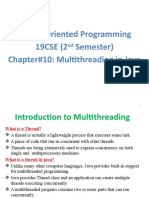0% found this document useful (0 votes)
22 views26 pagesMultithreading
The document provides an overview of multithreading in Java, explaining its definition, life cycle, and how to create threads using both the Runnable interface and by extending the Thread class. It details thread states, priorities, and methods, alongside examples demonstrating thread behavior and inter-thread communication using wait and notify. Additionally, it includes a producer-consumer scenario to illustrate practical multithreading concepts.
Uploaded by
mirshakishokCopyright
© © All Rights Reserved
We take content rights seriously. If you suspect this is your content, claim it here.
Available Formats
Download as PPTX, PDF, TXT or read online on Scribd
0% found this document useful (0 votes)
22 views26 pagesMultithreading
The document provides an overview of multithreading in Java, explaining its definition, life cycle, and how to create threads using both the Runnable interface and by extending the Thread class. It details thread states, priorities, and methods, alongside examples demonstrating thread behavior and inter-thread communication using wait and notify. Additionally, it includes a producer-consumer scenario to illustrate practical multithreading concepts.
Uploaded by
mirshakishokCopyright
© © All Rights Reserved
We take content rights seriously. If you suspect this is your content, claim it here.
Available Formats
Download as PPTX, PDF, TXT or read online on Scribd
/ 26




































































































